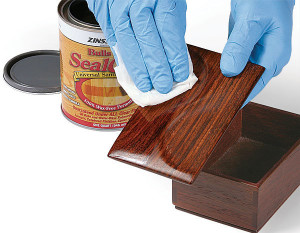Choosing the Best Finish for Your Work
Choosing the right finish for your project can be extremely difficult, especially when there are so many to choose from. But, there are some basic questions that can help determine which finish is right for your project.
How Will the Project be Used?
Projects for outdoor use require a different finish then say a top coat for a salad bowl. Nail down the specific use and demands of your project before applying a finish. For projects that will not be subject to excessive sun or moisture, consider using lacquer, shellac, oil or oil-varnish blends. You might find wiping a couple coats of paste furniture wax will work fine as a finish. All of these finishes are easy to repair if they are scratched. One important thing to note is not all paste wax, oils, shellac, lacquer and some water-based finishes can be damaged if exposed to water for long periods of time. Also, shellac is not resistant to alkalis like ammonia and lacquer will break down in the presence of alcohols.
In regards to food contact there really is no “best” finish. Mineral oil will not go rancid and is great option for cutting board projects. An option for food baskets and bowls is several coats of de-waxed shellac. It seals the wood against water penetration and can be easily cleaned with a damp cloth. Shellac is an excellent finish for toys that children may put in their mouth. Some water-based varnishes are also child-safe, but always read the label carefully.
How Do You Want the Wood to Look?
For natural-looking finishes wipe on several coasts of tung oil, linseed oil or use a varnish blend. However any finish such as shellac, lacquer or varnish can produce the same effect as long as you don’t build up the finish beyond several coats. A great tip is to thin the finish using the appropriate solvent making it flow more evenly in the pores of the wood.
To achieve a more elegant, glass-smooth finish choose a hard, film-forming finish like shellac, lacquer or varnish. As a general rule, oils and oil-based varnishes build luster best, followed by solvent-based lacquers and shellac.
How Clean, Warm and Dry is Your Shop?
If your working area is cold or filled with dust, fast-drying finishes like spray-on lacquer and shellac are good choices. Falling dust in the finish will not be as problematic as slow-drying finishes like oil-based varnish. Shellac and lacquer are easy to use in cold temperatures, and they can be modified with additives for use in hot and humid conditions as well.
Some Things to Remember
Finishes contain harmful chemicals that can be dangerous without proper safety precautions. Remember to wear lightweight gloves to protect your skin and safety glasses to guard your eyes. Work in a well ventilated area to combat hazardous fume emissions. Never work near a gas furnace, wood-burning stove or other flame.
Following these general guidelines will allow you to successfully choose the correct finish for your project and maintain your safety.
Tags: oil based finishes, paint brushes, water based finishes, wood finishes, woodworking, woodworking project ideas, woodworking projects
Leave a Reply




